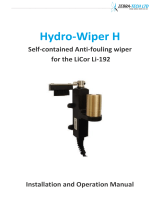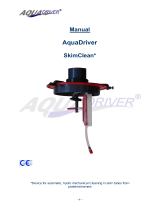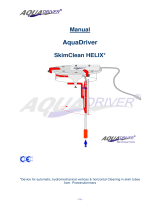
Hydro-Wiper
Operation Manual

Hydro-Wiper operation manual
Zebra-Tech Ltd
1
Overview
The Hydro-Wiper is a mechanical wiper system designed to be easily
fitted to optical turbidity sensors. By wiping at regular intervals, the
Hydro-Wiper keeps the optical window of the turbidity sensor clear of
biofouling and deposits such as mud and algae. This reduces the
necessity for costly site visits to manually clean the turbidity sensor,
and prevents on-going data loss due to fouling.
There are 3 models of Hydro-Wiper, for 3 specific turbidity sensors;
Hydro-Wiper model Turbidity sensor
Hydro-Wiper A Seapoint turbidity sensor
Hydro-Wiper B D&A OBS 3
Hydro-Wiper C D&A OBS 3 +
Hydro-Wiper D Aqualogger 200
Hydro-Wiper E Aqualogger 210
The Hydro-Wiper consists of a wiper body that the turbidity sensor is
attached to. The wiper body is connected to a wiper control housing
by a cable. In addition to the batteries, the wiper control housing
contains the control electronics, power switch, wipe interval select
switch, and diagnostic LED.
As the Hydro-Wiper is fully self contained, incorporation into existing
instrument installations is simple. The low power control electronics
enable long deployments to be made, whilst the high precision wipe
interval timer on-board the Hydro-Wipe insures minimal clock drift
during long deployments.

Hydro-Wiper operation manual
Zebra-Tech Ltd
2
Installation
The turbidity sensor is mounted in the clamp at the front of the wiper.
Ensure that the turbidity sensor is positioned so that the flat face of
the optical window is looking directly away from the wiper, and that
the brush covers the whole face when it sweeps passed.
The brush should lightly sweep across the whole surface of the
optical window. If there is excessive brush pressure, battery life of
the Hydro-Wiper will be reduced and damage to the optical surface
of the turbidity sensor may occur.
If the brush pressure is insufficient, then contact between the brush
and optical window will be lost in the centre of the window.
Brush pressure can be adjusted by loosening the nut at the end of
the wiper arm, and rotating the wiper arm in the desired direction.
The lock nut should be tightened after adjustment.
The wiper control housing should be mounted using the marine
grade (A4,316) stainless steel bracket that is attached to the
housing. Avoid attaching the bracket directly to a metal structure that
is not marine grade stainless steel, as this can cause electrolysis and
deterioration of the metal. Marine grade stainless steel bolts should
be used for fixing.
Once the wiper control housing and wiper housing are mounted,
secure the cable using cable ties to avoid possible snags and fouling
with debris. The cable should not be free to constantly move with the
water currents, as fatigue and eventual failure may result.

Hydro-Wiper operation manual
Zebra-Tech Ltd
3
Operation
To open the wiper control housing, unscrew the lid in an anti-
clockwise direction. If the lid is tight, the lid shifting tool supplied with
the Hydro-Wiper can be used. This tool fits into the groove in the top
face of the cap, and allows greater leverage. The lid shifting tool
should never be used to tighten the lid.
Inside the wiper control housing is the battery holder, wipe interval
select switch, power switch, and diagnostic LED.
Photo 1. Wiper control housing.
The wipe interval is set using the wipe interval select switch (refer to
table 1). The wipe interval should be adjusted with the Hydro-Wiper
Power on -
off switch
LED
Wipe interval
select switch
Battery
pack
Mounting
bracket
Battery
connector
Power
switch
LED

Hydro-Wiper operation manual
Zebra-Tech Ltd
4
switched off. The optimal wipe interval will depend on environmental
conditions at the field site. Generally a wipe interval of 3 hours
should prove sufficient to keep the turbidity sensor clean in moderate
fouling conditions.
Wipe interval select
switch position
Wipe interval (minutes)
0 15
1 30
2 45
3 60
4 120
5 180
6 240
7 300
8 360
9 720
Table 1; Wipe interval select switch settings
Only good quality alkaline batteries should be used, such as
Energizer or Duracell.
The Hydro-Wiper wipe interval timer starts 0.5 seconds after the
power switch is turned on. The wipe interval is the time between the
start of one wipe, and the start of the next wipe.
To avoid the wiper from affecting the turbidity sensor measurements,
start the Hydro-Wiper out of sequence with the measurement
schedule. For example, if the turbidity sensor measurements are
scheduled every hour, then start the Hydro-Wiper at 30 minutes past
the hour.
When the Hydro-Wiper is switched on, the LED will blink every 15
seconds. Under normal operation, the LED will blink once. If a fault
condition exists, the LED will blink in a sequence as shown in the
table 2.

Hydro-Wiper operation manual
Zebra-Tech Ltd
5
LED Blink sequence Description
1 Normal operation
2 Previous wipe failed
3 Low battery shutdown
Table 2. LED blink sequence
Low battery shutdown occurs when the battery pack reaches around
6.5 volts. In this mode no further wipes are performed.
When the Hydro-Wiper is switched on, the wiper will perform an
immediate wipe.
When closing the battery housing cap prior to deploying, always
service the O-ring;
1) Using the O-ring pick provided with the Hydro-Wiper,
carefully remove the O-ring from the groove in the wiper
housing.
2) Clean the O-ring, and the O-ring groove using a tissue. Also
clean the sealing face on the inside of the cap.
3) Wipe some O-ring grease, provided with the Hydro-Wiper,
onto the sealing face on the inside of the cap, and also onto
the O-ring.
4) Replace the O-ring into the groove in the battery housing
Screw the cap onto the battery housing until it is just hand tight. Do
not over tighten or use the cap shifting tool to tighten the cap.
The wiper drive shaft features a slip mechanism, so the wiper arm
can be manually moved if necessary, without causing any damage.
This also protects the gearbox from damage in the event the wiper
arm is subject to force or shock loading.
The Hydro-Wiper routinely monitors the position of the wiper arm. If
the wiper arm is moved in front of the turbidity sensor, the Hydro-
Wiper will detect this, and move the wiper arm to one side.
If the wiper arm becomes jammed at any stage during a wipe, the
direction of rotation will be reversed in an attempt to dislodge the
obstruction. If this is un-successful, the Hydro-Wiper will abort the

Hydro-Wiper operation manual
Zebra-Tech Ltd
6
wipe. The diagnostic LED will flash twice every 15 seconds whilst
this situation continues.
Maintenance
The Hydro-Wiper requires very little maintenance, and should
provide reliable operation for many years.
The only user replaceable part, apart from the batteries, is the brush.
Under normal conditions, the brush should last many thousands of
wipes. If however the brush does need replacement, these can be
obtained from your supplier or directly from Zebra-Tech Ltd.

Hydro-Wiper operation manual
Zebra-Tech Ltd
7
Specifications
Wipe interval; User select (15,30,45,60,120,180,240,300,360 or 720
minutes)
Clock accuracy; +/- 1 minute per year (0 - 40° C)
Power supply; 6 x Alkaline AA batteries
Power consumption; Quiescent, 0.02mA, ~ 80 mA during a wipe
Deployment endurance; Wipe interval dependent. In excess of 4
months with a 2 hour wipe interval
Brush; User replaceable
Battery Housing O-ring; #142 (2 3/8” x 3/32”)
Construction; Stainless steel, acetal
Wiper shaft; Multiple bearing support with quad ring seal
Depth rating; 30m
Cable; EPDM jacketed cable between the wiper and battery housing
(1 meter standard length).
Cable entry; Cable glands with O-ring sealed back-inserts.
Options
Extended depth rating; 100m
Impulse wet pluggable connectors on the wiper and/or battery
housing
Additional cable between the wiper and battery housing
External trigger input to control the wiper

Hydro-Wiper operation manual
Zebra-Tech Ltd
8
Contact
Zebra-Tech Ltd
PO Box 1668
Nelson
New Zealand
Tel: International 0064 3 5471590
Fax: International 0064 3 5471598
Email: [email protected]
Web: www.zebra-tech.co.nz
Designed and manufactured in New Zealand
-
 1
1
-
 2
2
-
 3
3
-
 4
4
-
 5
5
-
 6
6
-
 7
7
-
 8
8
-
 9
9
Campbell Scientific Hydro-Wiper-C Operation Owner's manual
- Type
- Owner's manual
- This manual is also suitable for
Ask a question and I''ll find the answer in the document
Finding information in a document is now easier with AI
Related papers
Other documents
-
 NexSens M-ARM-P User manual
NexSens M-ARM-P User manual
-
YSI EXO User manual
-
YSI ADV6600 Owner's manual
-
Proteus PROTEUS User manual
-
 AquaDriver SkimClean User manual
AquaDriver SkimClean User manual
-
YSI 6-Series Owner's manual
-
 Hach SOLITAX sc User manual
Hach SOLITAX sc User manual
-
ABB Aztec ATS430 Operating Instructions Manual
-
 AquaDriver SkimClean HELIX User manual
AquaDriver SkimClean HELIX User manual
-
Chevrolet 2019 Low Cab Forward Owner's manual












